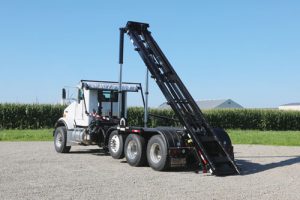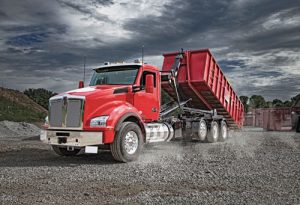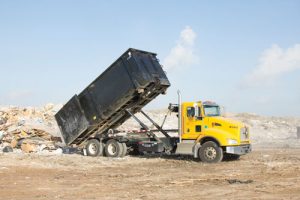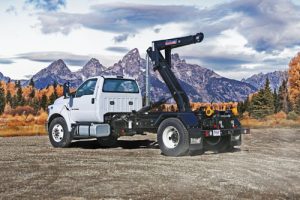When evaluating which unit may be best for productivity, understanding the primary difference between the hooklift and cable hoist systems is the first step, with that difference being how an operator connects to a container.
By Tim Worman and Rachel Lynch
When it comes to loading containers or truck bodies onto a truck chassis, regions around the world have traditionally opted for different equipment. The North American waste and recycling market usually favors the cable hoist, while the hooklift has been more prominent internationally.

One trend that all customers are impacted by is improved productivity in their daily operations, primarily how to obtain more picks per day. When evaluating which unit may be best for productivity, understanding the primary difference between the two systems is the first step, with that difference being how an operator connects to a container.
A cable hoist uses a cable that is manually connected to a container for loading and unloading onto a truck using a hydraulically operated reeving system, whereas a hooklift hoist uses a hook assembly to connect to containers, from the cab of the chassis, to load and unload on the truck. Both can provide loading and off-loading of waste and recyclable containers at any site, when matched with a properly configured truck chassis.
Which System is Right for You?
How does an operator decide which system is right for them? Ultimately, the best option depends on the application and systems already in place. The biggest reason that certain markets, including recycling and waste, use a lot of cable hoists still today is that their fleet of containers are set up for cable hoists, not hooklifts, and the cost to convert them means it usually does not make business sense to do so. As we have looked at the variables between the two markets, the hooklift makes the most sense if you are new to thebusiness, or doing a large-scale equipment swap, due to the expense
of converting containers for hooklift use.
In North America, cable hoists are still most commonly used for refuse and recycling, mixed waste, scrap and C&D hauling. The refuse and recycling market are really where cable hoists live. If you look at refuse, especially with larger setups, the cable hoist is the equipment that everybody uses because their containers are set up for it. Cable hoists fit well for big refuse collection companies. When you look at the
recycling market, primarily scrap, they also use cable hoists. It is a very mature market and that is what they started with.

While the cable hoist may be the right choice for existing hauling companies, if one is a new start-up in the hauling refuse or recyclables market, consider going straight to a hooklift due to their improved versatility, efficiency and safety gains.
The Benefits of Hooklift Hoists
One of the key benefits of the hooklift is that it not only efficiently handles containers, but there is also a magnitude of different bodies that can easily be swapped in and out. There is a litany of things you can do with that single asset for the job you need to do that day. You do not need to have five trucks sitting around, when one truck can easily be configured for different tasks using various interchangeable bodies. You can have one truck with five beds, and you just adapt to what you are going to do the next day.
Efficiency when collecting containers is another factor to consider when comparing hooklifts to cable hoists. With a cable hoist, the operator process limits the number of picks they can do per day. They have to get out of the truck, pull the cable out, hook the cable to the container, return to the truck, and proceed to pull the container up. When they drop the container, this process is also followed, in reverse. This process happens with each pickup and drop of a container, but not with a hooklift.
When working with a hooklift, an operator eliminates extra steps to hook to a container. The user can deploy the hook, back up to the container, hook the container, and pull it onto the truck all from the truck cab. The elimination of continuously entering and existing the cab with every pickup and drop greatly increases work efficiency.
We have looked at this closely, and in our estimation, if you were to switch to a hooklift, you could go from 10 picks per day to roughly 12 picks per day. In this scenario that would be a 12 percent gain in efficiency. By doing that with a single asset, you are putting more money into the profitability of your organization.

Another important benefit of a hooklift is its safer operation. It is key to remember that users of any demountable should always check the job site before deploying anything, whichever system they use. There should never be people or obstructions around containers, the truck or overhead.
One element of the hooklift is that when the operator is dropping or picking up a container, they never have to leave the cab. They can do it all from the comfort of their seat. The safer operation comes with a hooklift because you are not putting the operator between the container and the truck at any time to hook to, or disconnect from, a container. That cannot be said for the cable hoist.
Another safety factor is the mitigation of operators walking in unfavorable conditions, like mud, where they do not have to drag the large, heavy cable through the environment to hook to the container. With the cable hoist process, you could see an increase in injuries, such as back, hand or muscle pulls. These injuries are largely eliminated by having operators do the work from the truck cab—which they can only do with a hooklift.
Other Trends

There are additional trends to investigate as you look into equipment. Advances in electronic controls, which allow for options like autoload and drop, or implementing multi-location camera systems to equipment are becoming more popular as well. With increased visualization and ease of operation, operators can increase efficiency and productivity even more.
Finally, your business needs will factor into your decision of which equipment route to go and even though demount equipment may not change often or dramatically, there are plenty of
incremental advances that are leading to more productive, efficient and safer products every year. | WA
Tim Worman is Senior Product Manager for Stellar Industries. He can be reached at [email protected].
Rachel Lynch is Public Relations and Events Specialist for Stellar Industries. She can be reached at (641) 860-0517 or e-mail [email protected].
Stellar Industries was founded in 1990 in Garner, IA. Through the use of continually growing product lines and an expanding distributor network, its products have gained an international presence and have become the number one choice in many of the markets it serves. Products include telescopic cranes, articulating cranes, hooklifts, cable hoists, container carriers and tarping systems. Stellar Industries also offers complete tire service truck packages and mechanic service truck packages. For more information, call (641) 923-3741 or visit www.stellarindustries.com.
